High Temperature Tribological Behavior of Electroless Plating Ni-P-Si3N4-WS2 Composite Coatings
Abstract
1. Introduction
2. Materials and Methods
2.1. Preparation of Composite Coatings
2.2. Characterization and Wear Test
3. Results and Discussions
3.1. Microstructure of the Coatings
3.2. Mechanical Properties
3.3. Wear Behavior at Room Temperature
3.4. Wear Behavior at High Temperature
3.5. Wear Rate of the Coatings
4. Conclusions
Author Contributions
Funding
Institutional Review Board Statement
Informed Consent Statement
Data Availability Statement
Conflicts of Interest
References
- Sudagar, J.; Lian, J.; Sha, W. Electroless nickel, alloy, composite and nanocoatings—A critical review. J. Alloys Compd. 2013, 571, 183–204. [Google Scholar] [CrossRef]
- Vitry, V.; Hastir, J.; Mégret, A.; Yazdani, S.; Yunacti, M.; Bonin, L. Recent advances in electroless nickel-boron coatings. Surf. Coat. Technol. 2022, 429, 127937. [Google Scholar] [CrossRef]
- Zeng, L.; Wang, C.; Li, Y.; Hu, T. Synthesis of core-shell Ti@Ni-P spherical powder by Ni electroless plating. Micron 2021, 143, 103027. [Google Scholar] [CrossRef] [PubMed]
- Wang, Y.; Li, Y.; Cao, S.; Yu, J. Ni-P cluster modified carbon nitride toward efficient photocatalytic hydrogen production. Chin. J. Catal. 2019, 40, 867–874. [Google Scholar] [CrossRef]
- Salicio-Paz, A.; Ugarte, I.; Sort, J.; Pellicer, E.; García-Lecina, E. Full Optimization of an Electroless Nickel Solution: Boosting the Performance of Low-Phosphorous Coatings. Materials 2021, 14, 1501. [Google Scholar] [CrossRef]
- Chen, J.; Zhao, G.; Matsuda, K.; Zou, Y. Microstructure evolution and corrosion resistance of Ni–Cu–P amorphous coating during crystallization process. Appl. Surf. Sci. 2019, 484, 835–844. [Google Scholar] [CrossRef]
- Li, J.; Sun, C.; Roostaei, M.; Mahmoudi, M.; Fattahpour, V.; Zeng, H.; Luo, J.-L. Characterization and corrosion behavior of electroless Ni-Mo-P/Ni-P composite coating in CO2/H2S/Cl− brine: Effects of Mo addition and heat treatment. Surf. Coat. Technol. 2020, 403, 126416. [Google Scholar] [CrossRef]
- Liu, B.; Zhang, Q.; Li, Y.; Yang, Y.; Zhang, T.; Wang, Y.; Shao, Y.; Sun, H.; Wang, Z.; Wang, F. Optimization of the Corrosion Resistance of Electroless Ni–W–P Coatings on Magnesium Alloys by the Response Surface Methodology. Coatings 2021, 11, 18. [Google Scholar] [CrossRef]
- Kundu, S.; Das, S.K.; Sahoo, P. Friction and wear behavior of electroless Ni-P-W coating exposed to elevated temperature. Surf. Interfaces 2019, 14, 192–207. [Google Scholar] [CrossRef]
- Ghavidel, N.; Allahkaram, S.R.; Naderi, R.; Barzegar, M.; Bakhshandeh, H. Corrosion and wear behavior of an electroless Ni-P/nano-SiC coating on AZ31 Mg alloy obtained through environmentally-friendly conversion coating. Surf. Coat. Technol. 2020, 382, 125156. [Google Scholar] [CrossRef]
- Ebrahimian-Hosseinabadi, M.; Azari-Dorcheh, K.; Vaghefi, S.M. Wear behavior of electroless Ni-P-B4C composite coatings. Wear 2006, 260, 123–127. [Google Scholar] [CrossRef]
- León-Patiño, C.; García-Guerra, J.; Aguilar-Reyes, E. Tribological characterization of heat-treated Ni-P and Ni-P-Al2O3 composite coatings by reciprocating sliding tests. Wear 2019, 426, 330–340. [Google Scholar] [CrossRef]
- Wang, S.; Huang, X.; Gong, M.; Huang, W. Microstructure and mechanical properties of Ni-P-Si3N4 nanowire electroless composite coatings. Appl. Surf. Sci. 2015, 357, 328–332. [Google Scholar] [CrossRef]
- Dhakal, D.R.; Kshetri, Y.K.; Gyawali, G.; Kim, T.-H.; Choi, J.-H.; Lee, S.W. Understanding the effect of Si3N4 nanoparticles on wear resistance behavior of electroless Nickel-Phosphorus coating through structural investigation. Appl. Surf. Sci. 2021, 541, 148403. [Google Scholar] [CrossRef]
- Yuxin, W.; Xin, S.; Shanghai, W.; Chuming, L.; Wei, G.; RA, S.; Ramazan, K. Duplex Ni-P-ZrO2/Ni-P electroless coating on stainless steel. J. Alloys Compd. 2015, 630, 189–194. [Google Scholar] [CrossRef]
- Sivandipoor, I.; Ashrafizadeh, F. Synthesis and tribological behaviour of electroless Ni–P-WS2 composite coatings. Appl. Surf. Sci. 2012, 263, 314–319. [Google Scholar] [CrossRef]
- Sumi, V.; Sha, M.A.; Arunima, S.; Shibli, S. Development of a novel method of NiCoP alloy coating for electrocatalytic hydrogen evolution reaction in alkaline media. Electrochim. Acta 2019, 303, 67–77. [Google Scholar] [CrossRef]
- Muraliraja, R.; Sudagar, J.; Elansezhian, R.; Raviprakash, A.V.; Dhinakaran, R.; Shaisundaram, V.S.; Chandrasekaran, M. Estimation of Zwitterionic Surfactant Response in Electroless Composite Coating and Properties of Ni–P–CuO (Nano) Coating. Arab. J. Sci. Eng. 2019, 44, 821–828. [Google Scholar] [CrossRef]
- Taye, D.; Mohanty, S.; Das, A.K.; Singh, N.K. Electroless Ni–Al2O3–WS2 Composite Coating on Aluminum Substrate. Trans. Indian Inst. Met. 2019, 72, 2281–2292. [Google Scholar] [CrossRef]
- Chinchu, K.; Riyas, A.; Sha, M.A.; Geethanjali, C.; Saji, V.S.; Shibli, S. ZrO2–CeO2 assimilated electroless Ni–P anti-corrosion coatings. Surf. Interfaces 2020, 21, 100704. [Google Scholar] [CrossRef]
- Nemane, V.; Chatterjee, S. Evaluation of microstructural, mechanical, and tribological characteristics of Ni-B-W-SiC electroless composite coatings involving multi-pass scratch test. Mater. Charact. 2021, 180, 111414. [Google Scholar] [CrossRef]
- Holmberg, K.; Laukkanen, A.; Ghabchi, A.; Rombouts, M.; Turunen, E.; Waudby, R.; Suhonen, T.; Valtonen, K.; Sarlin, E. Computational modelling based wear resistance analysis of thick composite coatings. Tribol. Int. 2014, 72, 13–30. [Google Scholar] [CrossRef]
- Parsazadeh, M.; Fisher, G.; McDonald, A.; Hogan, J.D. Computational modelling of the effect of microstructure on the abrasive wear resistance of tungsten-carbide nickel composite coatings under sub-critical cyclic impact loading. Ceram. Int. 2022, 48, 14338–14348. [Google Scholar] [CrossRef]
- Jamari, J.; Ammarullah, M.I.; Santoso, G.; Sugiharto, S.; Supriyono, T.; Permana, M.S.; Winarni, T.I.; van der Heide, E. Adopted Walking Condition for Computational Simulation Approach on Bearing of Hip Joint Prosthesis: Review over the Past 30 Years. Heliyon 2022, 8, e12050. [Google Scholar] [CrossRef] [PubMed]
- Ren, Q.; Cui, G.; Li, T.; Hassani, M.; Liu, Y.; Kou, Z. High-temperature wear behavior of cobalt matrix composites reinforced by LaF3 and CeO2. Tribol. Lett. 2021, 69, 149. [Google Scholar] [CrossRef]
- Donnet, C.; Erdemir, A. Solid lubricant coatings: Recent developments and future trends. Tribol. Lett. 2004, 17, 389–397. [Google Scholar] [CrossRef]
- Torres, H.; Ripoll, M.R.; Prakash, B. Tribological behaviour of self-lubricating materials at high temperatures. Int. Mater. Rev. 2018, 63, 309–340. [Google Scholar] [CrossRef]
- Li, Z.; Wang, J.; Lu, J.; Meng, J. Tribological characteristics of electroless Ni–P–MoS2 composite coatings at elevated temperatures. Appl. Surf. Sci. 2013, 264, 516–521. [Google Scholar] [CrossRef]
- Du, S.; Li, Z.; He, Z.; Ding, H.; Wang, X.; Zhang, Y. Effect of temperature on the friction and wear behavior of electroless Ni–P–MoS2–CaF2 self-lubricating composite coatings. Tribol. Int. 2018, 128, 197–203. [Google Scholar] [CrossRef]
- Ürdem, Ş.; Duru, E.; Algül, H.; Uysal, M.; Akbulut, H. Evaluation of high temperature tribological behavior of electroless deposited NiB–Al2O3 coating. Wear 2021, 482, 203960. [Google Scholar] [CrossRef]
- Tyagi, R.; Das, A.; Mandal, A. Electrical discharge coating using WS2 and Cu powder mixture for solid lubrication and enhanced tribological performance. Tribol. Int. 2018, 120, 80–92. [Google Scholar] [CrossRef]
- Kundu, S.; Das, S.K.; Sahoo, P. Properties of electroless nickel at elevated temperature-a Review. Procedia Eng. 2014, 97, 1698–1706. [Google Scholar] [CrossRef]
- Hasan, A.; Mehmet, U.; Ahmet, A. A comparative study on morphological, mechanical and tribological properties of electroless NiP, NiB and NiBP coatings. Appl. Surf. Sci. Adv. 2021, 4, 10089. [Google Scholar] [CrossRef]
- Apachitei, I.; Tichelaar, F.D.; Duszczyk, J.; Katgerman, L. The effect of heat treatment on the structure and abrasive wear resistance of autocatalytic NiP and NiP-SiC coatings. Surf. Coat. Technol. 2002, 149, 263–278. [Google Scholar] [CrossRef]
- Buchtík, M.; Doskočil, L.; Brescher, R.; Doležal, P.; Másilko, J.; Wasserbauer, J. The Effect of Crystallization and Phase Transformation on the Mechanical and Electrochemical Corrosion Properties of Ni-P Coatings. Coatings 2021, 11, 447. [Google Scholar] [CrossRef]
- Balaraju, J.N.; Narayanan, T.S.N.S.; Seshadri, S.K. Structure and phase transformation behaviour of electroless Ni–P composite coatings. Mater. Res. Bull. 2006, 41, 847–860. [Google Scholar] [CrossRef]
- Uysal, M. Electroless codeposition of Ni-P composite coatings: Effects of graphene and TiO2 on the morphology, corrosion, and tribological properties. Metall. Mater. Trans. 2019, 50, 2331–2341. [Google Scholar] [CrossRef]
- Ni, M.; Wang, S.; Li, W.; Huang, W. A novel self-lubricating Ni-P-AlN-WS2 nanocomposite coating. Mater. Res. Express 2019, 6, 116413. [Google Scholar] [CrossRef]
- Gültekin, D.; Duru, E.; Akbulut, H. Improved wear behaviors of lead-free electroless NiB and Ni-B/CeO2 composite coatings. Surf. Coat. Technol. 2021, 422, 127525. [Google Scholar] [CrossRef]




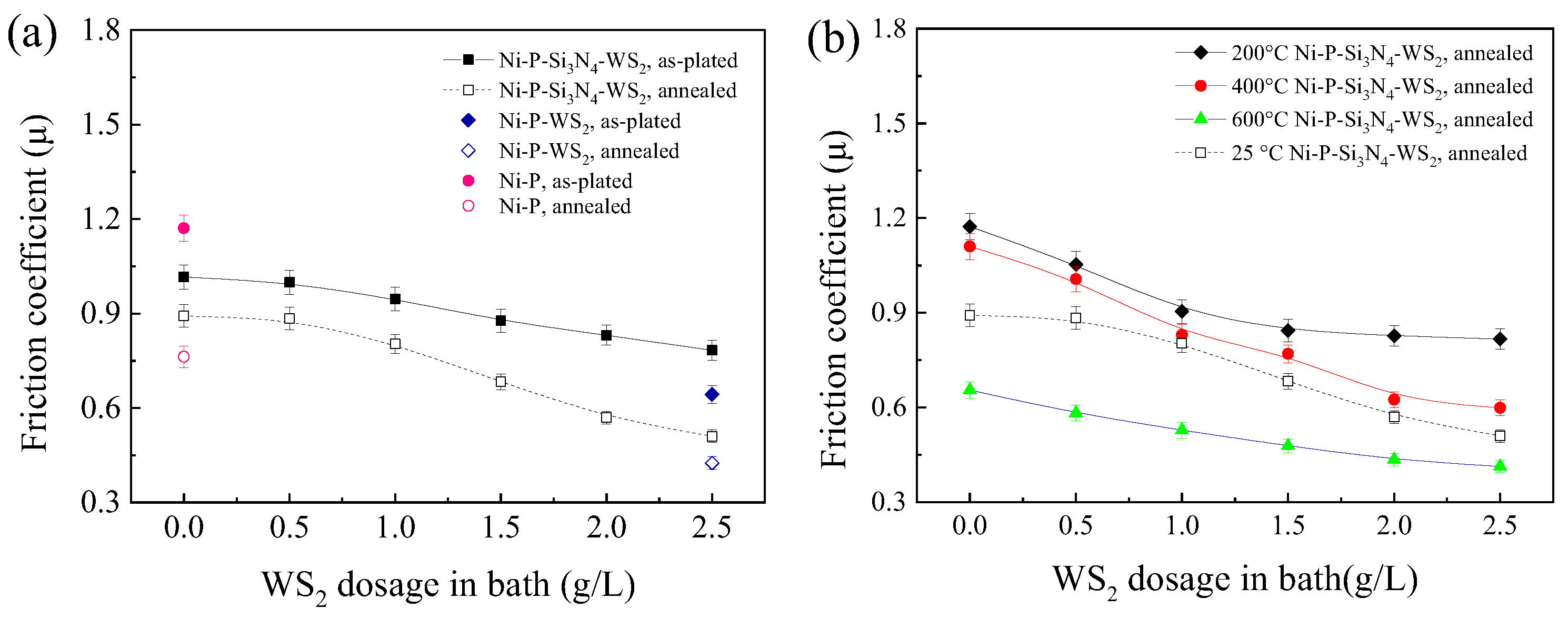
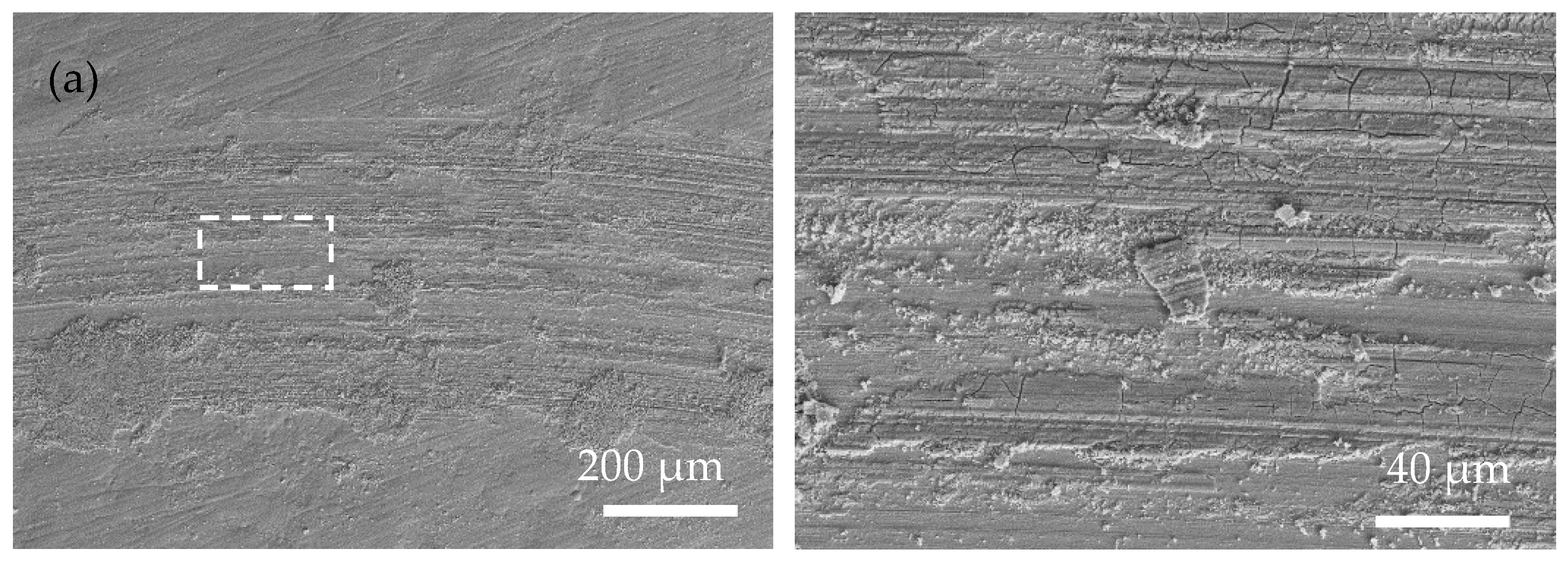
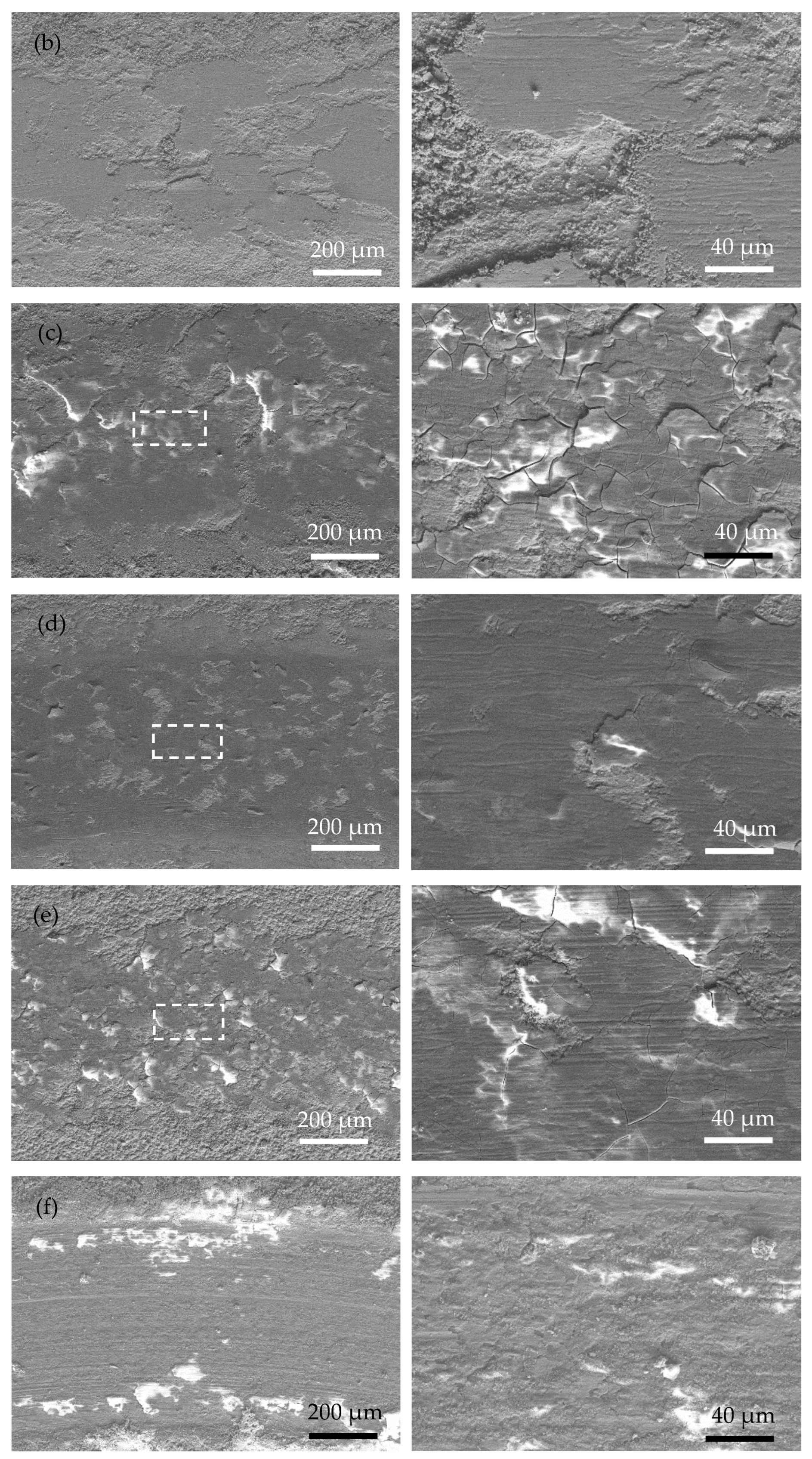
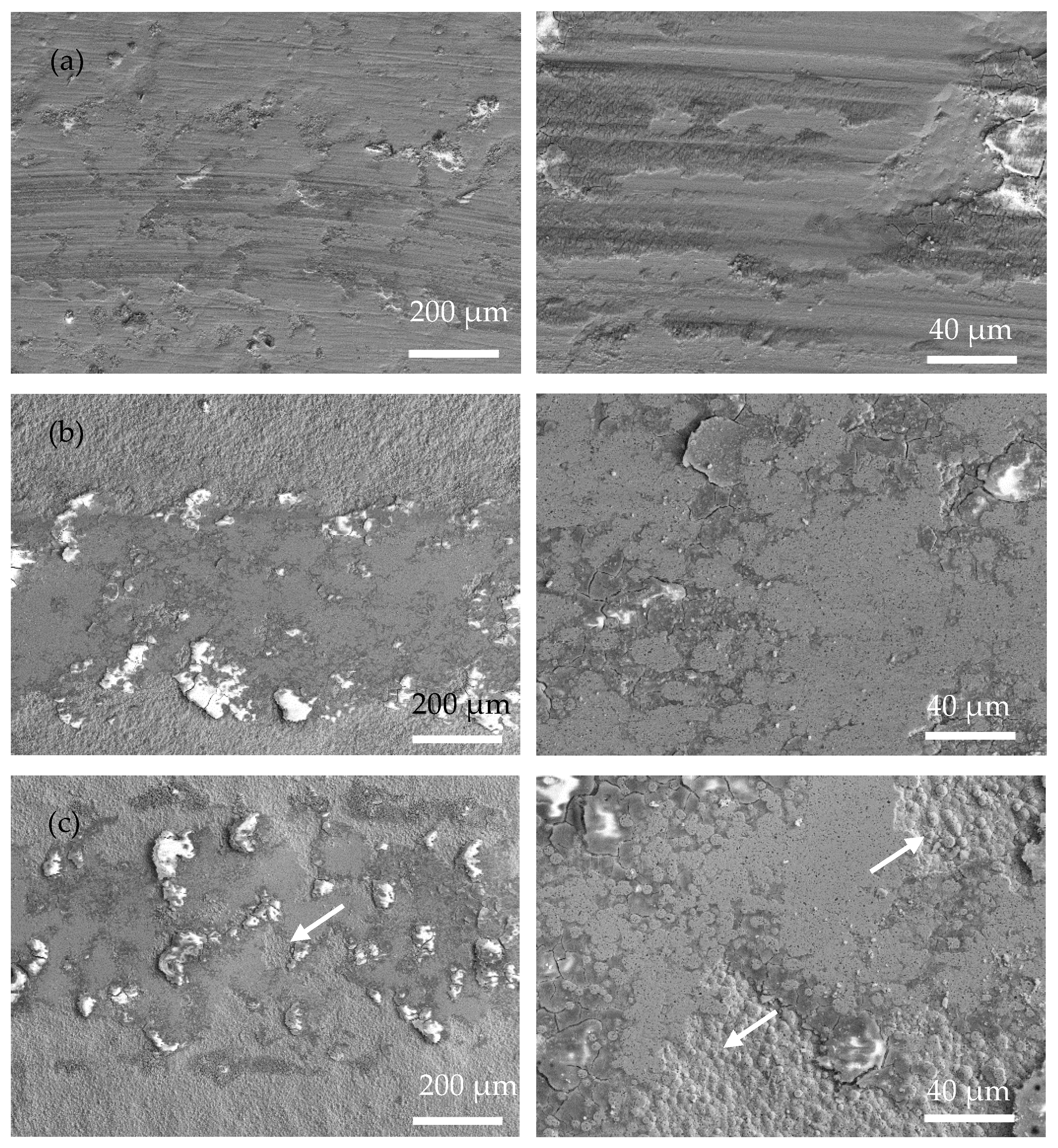
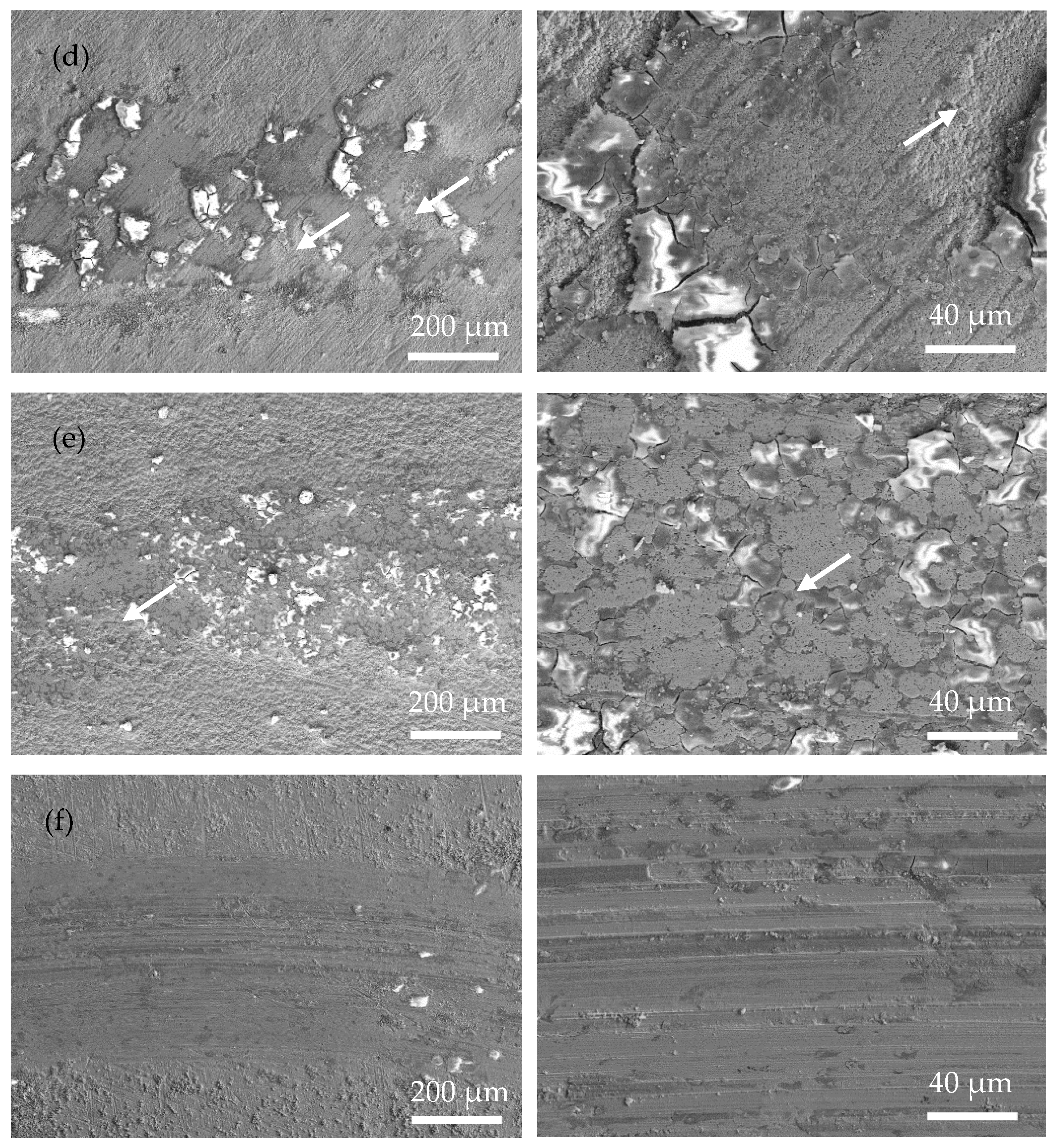
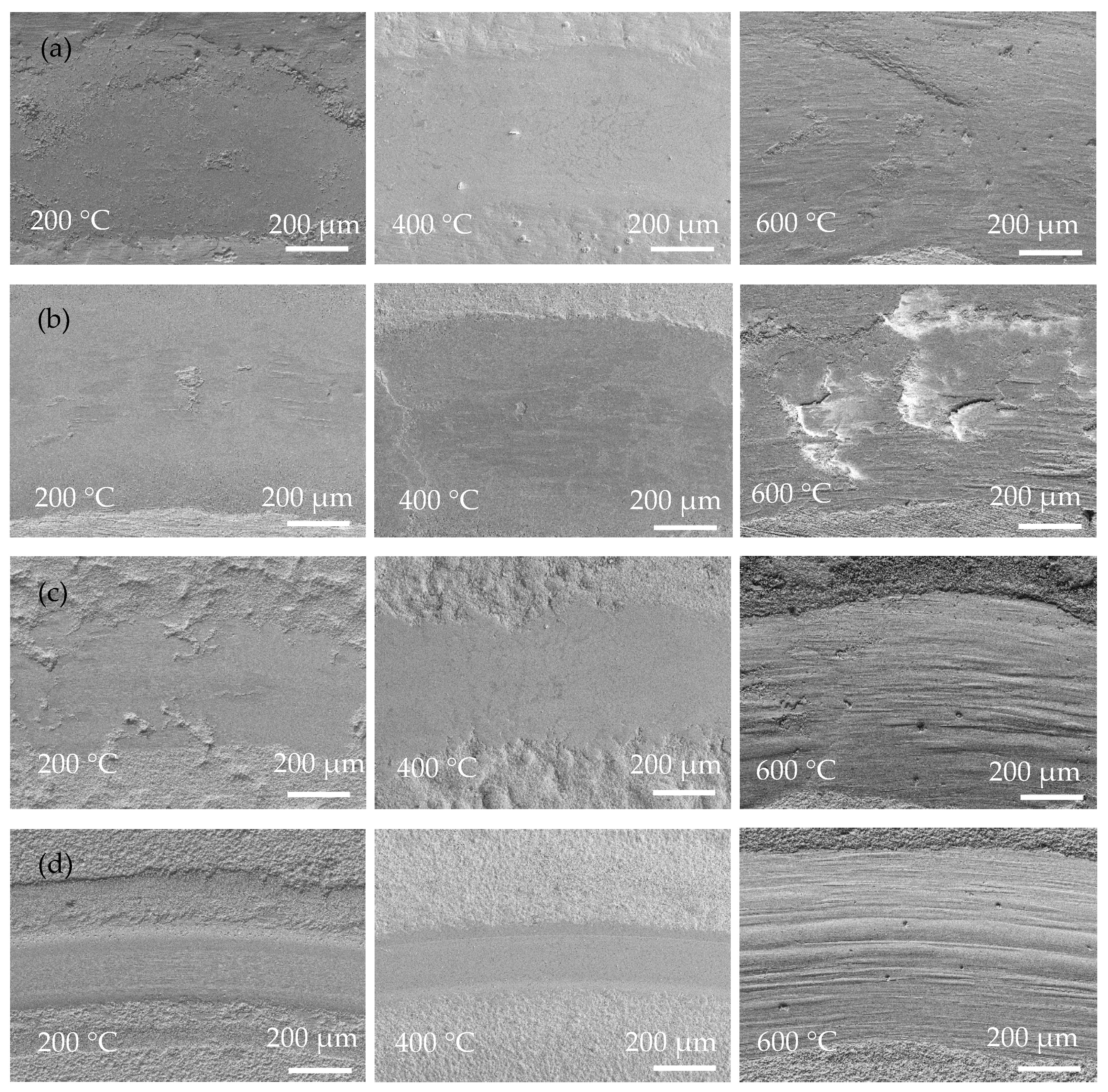
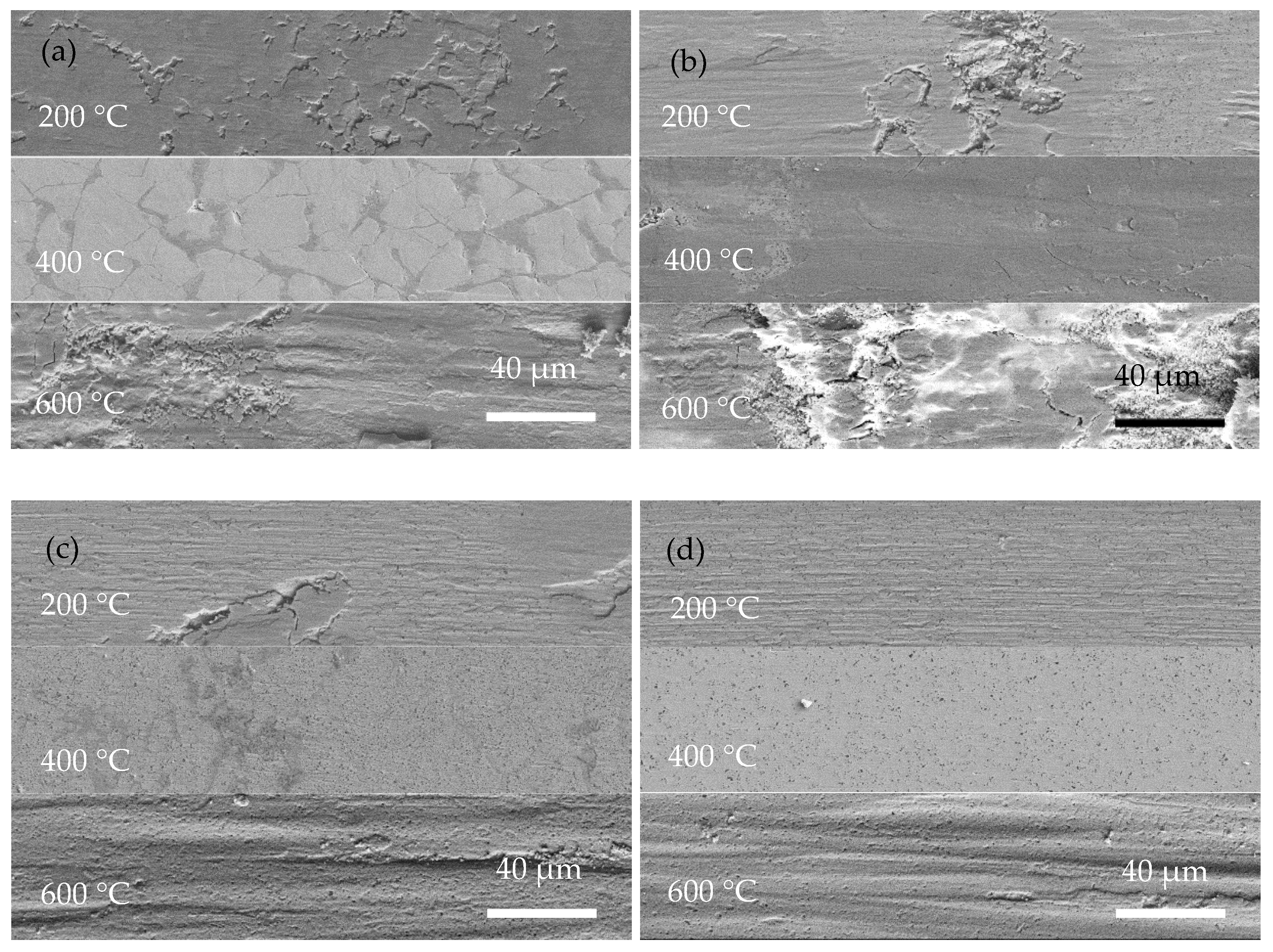
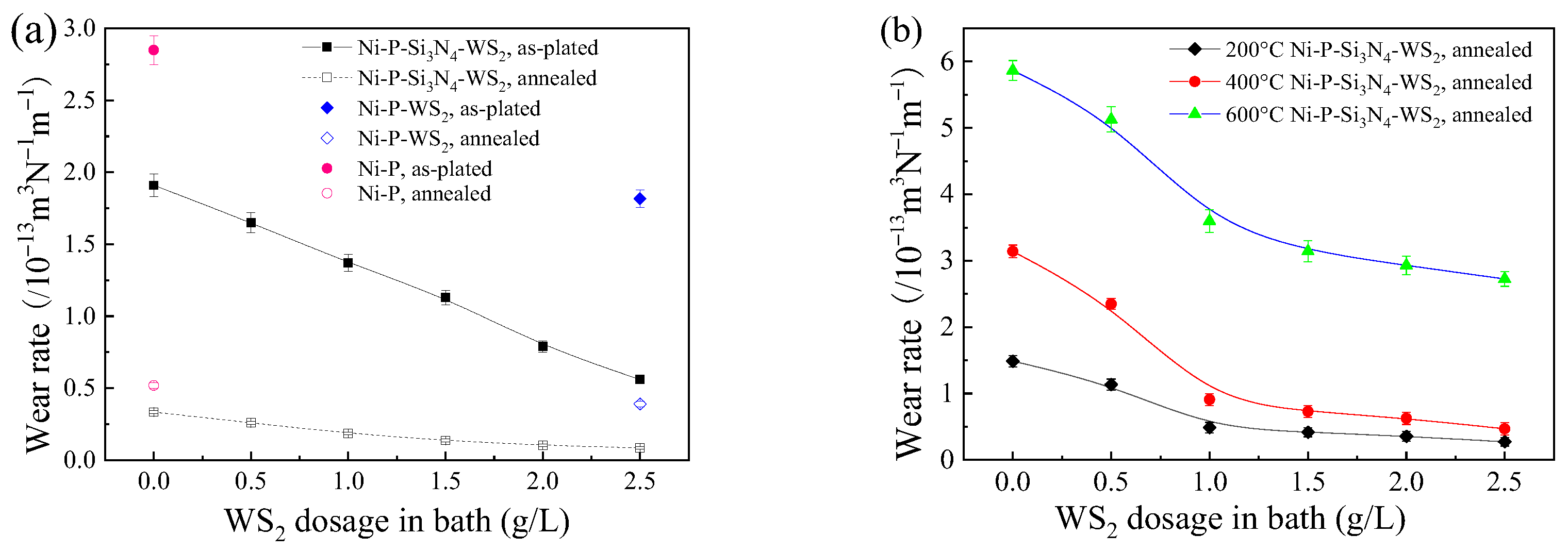
| Components of the Bath | Dosage (g/L) |
|---|---|
| Nickel sulfate | 25 |
| Sodium hypophosphite | 30 |
| Sodium citrate | 15 |
| Sodium acetate | 15 |
| Glycine | 5 |
| Succinic acid | 5 |
| Stabilizer Si3N4 powders | Appropriate dosage 5.0 |
| WS2 powders | 0, 0.5, 1.0, 1.5, 2.0, 2.5 |
| Element | Ni-P | Ni-P-WS2 | Ni-P-Si3N4-WS2 | |||||
|---|---|---|---|---|---|---|---|---|
| 0 g/L | 0.5 g/L | 1.0 g/L | 1.5 g/L | 2.0 g/L | 2.5 g/L | |||
| Ni | 89.3 ± 2.2 | 81.0 ± 2.1 | 71.8 ± 1.8 | 75.1 ± 1.9 | 76.8 ± 1.9 | 75.9 ± 1.9 | 75.3 ± 1.9 | 75.9 ± 1.9 |
| P | 10.1 ± 0.3 | 10.0 ± 0.3 | 7.7 ± 0.3 | 7.0 ± 0.3 | 7.4 ± 0.3 | 7.3 ± 0.3 | 7.1 ± 0.3 | 7.1 ± 0.3 |
| Si | - | - | 12.4 ± 0.3 | 8.8 ± 0.3 | 8.2 ± 0.3 | 8.0 ± 0.3 | 7.6 ± 0.3 | 7.4 ± 0.3 |
| N | - | - | 7.1 ± 1.3 | 7.5 ± 1.4 | 5.9 ± 0.9 | 6.2 ± 1.0 | 6.1 ± 0.9 | 5.6 ± 0.8 |
| S | - | 1.0 ± 0.1 | - | 0.1 ± 0.1 | 0.1 ± 0.1 | 0.3 ± 0.2 | 0.4 ± 0.2 | 0.5 ± 0.2 |
| W | - | 3.2 ± 0.1 | - | 0.4 ± 0.1 | 0.6 ± 0.1 | 1.3 ± 0.1 | 2.5 ± 0.1 | 2.5 ± 0.1 |
| O | 0.6 ± 0.2 | 4.8 ± 0.2 | 1.0 ± 0.2 | 0.9 ± 0.2 | 1.0 ± 0.2 | 1.0 ± 0.2 | 1.0 ± 0.2 | 0.8 ± 0.2 |
| Element | Ni-P | Ni-P-Si3N4-WS2 | ||
|---|---|---|---|---|
| 0.5 g/L | 1.5 g/L | 2.5 g/L | ||
| Ni | 77.3 | 70.1 | 50.3 | 54.6 |
| P | 8.0 | 5.8 | 4.4 | 4.2 |
| O | 12.7 | 16.8 | 33.3 | 32.6 |
| Si | 0.5 | 3.6 | 8.5 | 5.3 |
| N | 0.6 | 1.5 | 2.0 | 1.4 |
| S | ̵ | 0.1 | 0.1 | 0.2 |
| W | ̵ | 0.7 | 1.2 | 1.5 |
| Fe | 0.9 | 1.4 | 0.2 | 0.2 |
Disclaimer/Publisher’s Note: The statements, opinions and data contained in all publications are solely those of the individual author(s) and contributor(s) and not of MDPI and/or the editor(s). MDPI and/or the editor(s) disclaim responsibility for any injury to people or property resulting from any ideas, methods, instructions or products referred to in the content. |
© 2023 by the authors. Licensee MDPI, Basel, Switzerland. This article is an open access article distributed under the terms and conditions of the Creative Commons Attribution (CC BY) license (https://creativecommons.org/licenses/by/4.0/).
Share and Cite
Zheng, X.; Huang, Y.; Cai, C.; Huang, H.; Yang, F. High Temperature Tribological Behavior of Electroless Plating Ni-P-Si3N4-WS2 Composite Coatings. Coatings 2023, 13, 723. https://doi.org/10.3390/coatings13040723
Zheng X, Huang Y, Cai C, Huang H, Yang F. High Temperature Tribological Behavior of Electroless Plating Ni-P-Si3N4-WS2 Composite Coatings. Coatings. 2023; 13(4):723. https://doi.org/10.3390/coatings13040723
Chicago/Turabian StyleZheng, Xiaohua, Yindi Huang, Chenbin Cai, Haijun Huang, and Fanger Yang. 2023. "High Temperature Tribological Behavior of Electroless Plating Ni-P-Si3N4-WS2 Composite Coatings" Coatings 13, no. 4: 723. https://doi.org/10.3390/coatings13040723
APA StyleZheng, X., Huang, Y., Cai, C., Huang, H., & Yang, F. (2023). High Temperature Tribological Behavior of Electroless Plating Ni-P-Si3N4-WS2 Composite Coatings. Coatings, 13(4), 723. https://doi.org/10.3390/coatings13040723







